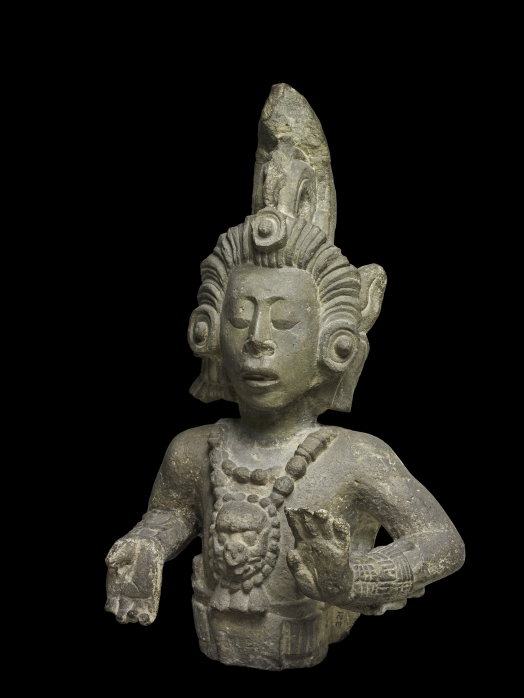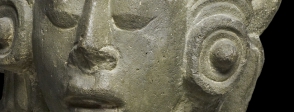
The statue was displayed, with others, on a pyramid style temple commissioned by Waxaklajuun Ub’aah K’awiil the 13th ruler of Copán, an important Maya city and religious centre.
The maize god
The Maya believed in an array of gods who represented aspects of nature, society and professions. The maize god, Hun Hunahpu, was one of the most important owing to his connection with this vital staple crop. He is shown here as a youthful, handsome man. His headdress is a stylised ear of corn and his hair is the silk of the corn.
The Popol Vuh, a sacred Maya book, describes how the gods formed the first humans from a dough made out of yellow and white maize after their attempts to use clay and wood had failed. The maize god was believed to be decapitated once harvesting began and then reborn at the start of the new growing season. The god was therefore not just associated with maize itself, but also with the cycle of rebirth, the cycle of seasons and the associated growth of crops. His life cycle could also provide the Maya with a way of understanding the human life cycle.
The importance of maize
Maize was the staple crop in Mesoamerica. It is a versatile grain which can be grown in the wet lowlands as well as the drier mountain areas. It flourishes when repeatedly harvested and cut down, and provides a rich nutritional carbohydrate foodstuff.
Unlike modern corn, ancient maize could not simply be boiled and eaten; it required much work to make it edible. The maize needed to be boiled with white lime to release the amino acids and vitamin B and then ground into a paste to produce an unleavened dough. Maize was often grown together with squash and beans, a combination known as the Three Sisters. The squash plants grow at ground level and keep down weeds, the maize plants grow straight up through the squash and the beans grow around and up the maize. All three plants work together to produce a nutritious combination of protein, carbohydrates and vitamins.
Turning to the gods
There were prolonged droughts during the Maya period which would have led to difficulties growing food crops and a poor harvest could herald extreme hardship and possible starvation. It was very important that the Maya had a reliable food source to depend on to allow their city-states to flourish and so in times of drought and poor harvest, the Maya turned to the gods responsible for food, rain and fertility.
Worship of the gods had both personal and formal aspects. On an individual level nobles were expected to give their own blood as a personal sacrifice during bloodletting rituals and households had access to shrines to perform individual or family rituals. But cities also had elaborate temple complexes where priests performed rites on behalf of the city and the king. These ceremonies were accompanied by music and dancing, they could include processions, feasting, ritual ball games as well as sacrifices and prayers.
More information
Introduction to the statue
The British Museum’s webpage about the statue.
http://www.britishmuseum.org/explore/highlights/highlight_objects/aoa/s/stone_bust_of_the_maize_god.aspx
A History of the World in 100 Objects
A History of the World in 100 Objects: listen to the programme or read the transcript.
http://www.bbc.co.uk/ahistoryoftheworld/objects/Hvi54RDiQym6Pgd3_IsRKA
Maya resources
A rich website devoted to the Maya from the Smithsonian National Museum of the American Indian. The Corn and Maya section provides relevant information for further research on this topic. You can also read about and watch a video telling the Creation story – click on the Maya section then click on the link to Creation Story of the Maya.
http://maya.nmai.si.edu/
Maya exhibition
A resource with a wealth of information about the Maya, designed for a past exhibition at the National Gallery of Art in Washington DC.
http://www.nga.gov/kids/mayakids.pdf
Map
An interactive map from National Geographic exploring information gathered during their expeditions and projects.
http://ngm.nationalgeographic.com/2007/08/maya-rise-fall/mission-project-interactive
Maya introduction
An educational webpage with information about the Maya.
http://www.mexicolore.co.uk/maya
More information
-
Introduction to the statue
The British Museum’s webpage about the statue.
Source: britishmuseum.org
-
A History of the World in 100 Objects
A History of the World in 100 Objects: listen to the programme or read the transcript.
Source: bbc.co.uk
-
Maya resources
A rich website devoted to the Maya from the Smithsonian National Museum of the American Indian. The Corn and Maya section provides relevant information for further research on this topic. You can also read about and watch a video telling the Creation story – click on the Maya section then click on the link to Creation Story of the Maya.
Source: nmai.si.edu
-
Maya exhibition
A resource with a wealth of information about the Maya, designed for a past exhibition at the National Gallery of Art in Washington DC.
Source: nga.gov
-
Map
An interactive map from National Geographic exploring information gathered during their expeditions and projects.
Source: nationalgeographic.com
-
Maya introduction
An educational webpage with information about the Maya.
Source: mexicolore.co.uk


